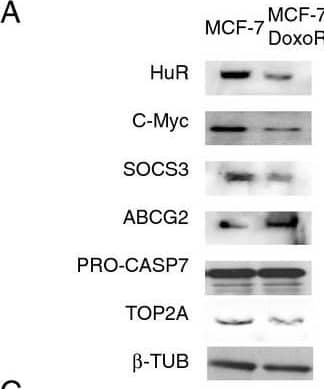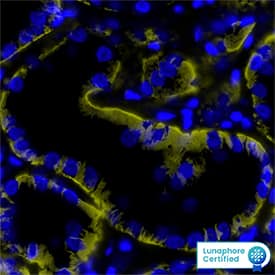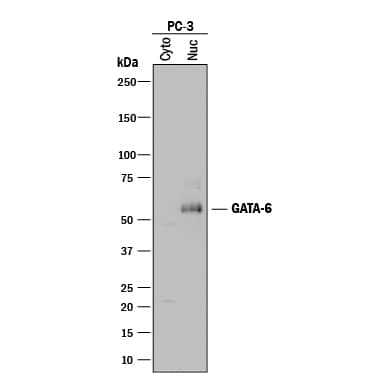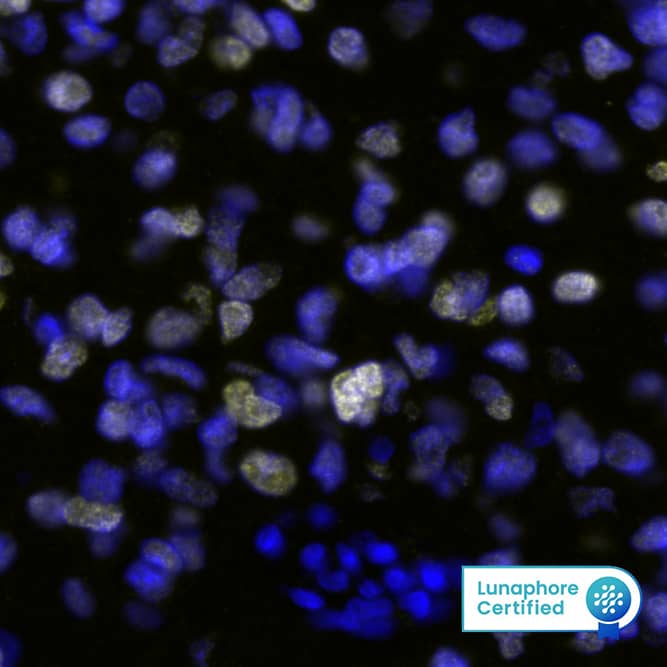Human ABCG2 Antibody Summary
Customers also Viewed
Applications
Please Note: Optimal dilutions should be determined by each laboratory for each application. General Protocols are available in the Technical Information section on our website.
Scientific Data
 View Larger
View Larger
ABCG2 in JAR Human Cell Line. ATP-Binding Cassette Transporter G2 (ABCG2) was detected in immersion fixed JAR human choriocarcinoma cell line using Mouse Anti-Human ABCG2 Monoclonal Antibody (Catalog # MAB995) at 10 µg/mL for 3 hours at room temperature. Cells were stained using the NorthernLights™ 493-conjugated Anti-Mouse IgG Secondary Antibody (green; NL009) and counterstained with DAPI (blue). View our protocol for Fluorescent ICC Staining of Cells on Coverslips.
 View Larger
View Larger
ABCG2 in Human ABCG2 transfected CHO Chinese Hamster Cell Line. ABCG2 was detected in immersion fixed Human ABCG2 transfected CHO Chinese hamster ovary cell line using Mouse Anti-Human ABCG2 Monoclonal Antibody (Catalog # MAB995) at 10 µg/mL for 3 hours at room temperature. Cells were stained using the NorthernLights™ 557-conjugated Anti-Mouse IgG Secondary Antibody (red; NL007) and counterstained with DAPI (blue). View our protocol for Fluorescent ICC Staining of Cells on Coverslips.
 View Larger
View Larger
ABCG2 in A549 Human Cell Line. ABCG2 was detected in immersion fixed A549 human lung carcinoma cell line using Mouse Anti-Human ABCG2 Monoclonal Antibody (Catalog # MAB995) at 8 µg/mL for 3 hours at room temperature. Cells were stained using the NorthernLights™ 557-conjugated Anti-Mouse IgG Secondary Antibody (red; Catalog # NL007) and counterstained with DAPI (blue). Specific staining was localized to plasma membrane. View our protocol for Fluorescent ICC Staining of Non-adherent Cells.
 View Larger
View Larger
Detection of ABCG2 in RPMI 8226 cells by Flow Cytometry RPMI 8226 cells were stained with Mouse Anti-Human ABCG2 Monoclonal Antibody (Catalog # MAB995, filled histogram) or isotype control antibody (Catalog # MAB0041, open histogram) followed by Phycoerythrin-conjugated Anti-Mouse IgG Secondary Antibody (Catalog # F0102B). View our protocol for Staining Membrane-associated Proteins.
 View Larger
View Larger
Detection of Human ABCG2/CD338 by Western Blot A. Characterization of MCF-7/DoxoR cells. Western blotting on whole cell lysates from parental (MCF-7) and doxorubicin resistant (MCF-7/DoxoR) MCF-7 cells. HuR, c-Myc, Socs3 and TOP2A are down regulated in the MCF-7/DoxoR cells in comparison with the parental, ABCG2 is up regulated. Caspase 7 expression level is not affected. Beta tubulin is the loading control. B. Characterization of MDA-MB-231/DoxoR and SK/NOdoxoR cells. Western blotting on whole cell lysates from parental (MDA-MB-231, SK) and doxo resistant (MDA/DoxoR) and doxo exposed (SK/NOdoxoR) cells. HuR and TOP2A are down regulated in the MDA-MB-231/DoxoR cells. Beta tubulin is the loading control. Protein quantification measured by densitometric analyses on three independent western blots. * p-value < 0.05 with respect to starved conditions. C. HuR does not translocate from the nucleus to the cytosol after doxorubicin treatment in MCF-7/DoxoR cells. Immunofluorescence (HuR in green, counterstaining DAPI in blue) on MCF-7 cells starved for 24 h and treated at increasing doxo concentration (from 1 to 50 μM) for 4 h. Quantification of HuR cytoplasmic translocation measured on immunofluorescence images by calculating the ratio of intensity signal in the nucleus and in the cytoplasm. D. An average of 300 cells for each experimental conditions were used. Z-score below zero indicates nuclear localization, above zero cytoplasmic localization. Quantification of HuR protein translocation after 10 μM doxo for 4 h measured by densitometric analyses on three independent western blots. E. Quantification of total HuR protein measured by densitometric analyses on three independent western blots. No change was observed neither in protein amount nor in protein translocation during doxo treatment. Image collected and cropped by CiteAb from the following open publication (https://pubmed.ncbi.nlm.nih.gov/22436134), licensed under a CC-BY license. Not internally tested by R&D Systems.
Preparation and Storage
- 12 months from date of receipt, -20 to -70 °C as supplied.
- 1 month, 2 to 8 °C under sterile conditions after reconstitution.
- 6 months, -20 to -70 °C under sterile conditions after reconstitution.
Background: ABCG2
Hematopoietic stem cells are known to express a membrane transporter molecule, known as P-glycoprotein (Pgp), that is encoded by the multidrug resistance gene 1 (MDR1) (1, 2). Expression of Pgp appears to confer a proliferative advantage to stem cells through its anti-apoptotic effects (3, 4). An additional transporter molecule known as ABCG2 (ATP-binding cassette gene 2) or Bcrp1 (Breast cancer resistance protein 1), first identified in a breast cancer cell line (5), is expressed on stem cells (6). ABCG2 belongs to a family of molecules that span the cell membrane six times and can exist as either homo or hetero dimers linked by a short intracellular flexible linker region that plays an important role in the efflux of a wide range of substrates (7, 8). Although these transporter molecules have initially been thought to play a role in drug resistance, they have been found to have utility in better characterizing primitive stem cells. For example, the “side-population” of hematopoietic stem cells, characterized by their inability to retain high levels of the intracellular staining dyes Hoechst 33342 and Rhodamine 123, has been found to express high levels of ABCG2. Of interest is the observation that ABCG2 function has been linked to the efflux of the Hoechst dye (6). Furthermore, there is now evidence that this monoclonal can be used as a cell surface marker to identify hematopoietic stem cells within the bone marrow fraction of lineage negative cells (6). The expression of ABCG2 appears greatest on CD34- cells and is downregulated with the acquisition of CD34 on the cell surface (6).
- Chaudhary, P.M. and I.B. Roninson (1991) Cell 66:85.
- Sorrentino, B.P. et al. (1995) Blood 86:491.
- Pallis, M. and N. Russell (2000) Blood 95:2897.
- Johnstone, R.W. et al. (1999) Blood 93:1075.
- Doyle, L.A. et al. (1998) Proc. Natl. Acad. Sci. USA 95:15665.
- Zhou, S. et al. (2001) Nat. Medicine 7:1028.
- Hrycyna, C.A. et al. (1998) Biochem. 37:13660.
- Bunting, K.D. (2002) Stem Cells 20:11.
Product Datasheets
Citations for Human ABCG2 Antibody
R&D Systems personnel manually curate a database that contains references using R&D Systems products. The data collected includes not only links to publications in PubMed, but also provides information about sample types, species, and experimental conditions.
11
Citations: Showing 1 - 10
Filter your results:
Filter by:
-
Microbial metabolite restricts 5-fluorouracil-resistant colonic tumor progression by sensitizing drug transporters via regulation of FOXO3-FOXM1 axis
Authors: S Ghosh, R Singh, ZM Vanwinkle, H Guo, PK Vemula, A Goel, B Haribabu, VR Jala
Theranostics, 2022-07-18;12(12):5574-5595.
Species: Human
Sample Types: Cell Lysates
Applications: Western Blot -
Transcriptional Heterogeneity in Naive and Primed Human Pluripotent Stem Cells at Single-Cell Resolution
Authors: T Messmer, F von Meyenn, A Savino, F Santos, H Mohammed, ATL Lun, JC Marioni, W Reik
Cell Rep, 2019-01-22;26(4):815-824.e4.
Species: Human
Sample Types: Whole Cells
Applications: ICC -
Effect of NOS1 regulating ABCG2 expression on proliferation and apoptosis of cervical cancer cells
Authors: M Ding, H Zhang, L Liu, R Liang
Oncol Lett, 2018-11-30;17(2):1531-1536.
Species: Human
Sample Types: Cell Lysates
Applications: Western Blot -
In�Vitro Modeling of Blood-Brain Barrier with Human iPSC-Derived Endothelial Cells, Pericytes, Neurons, and Astrocytes via Notch Signaling
Authors: K Yamamizu, M Iwasaki, H Takakubo, T Sakamoto, T Ikuno, M Miyoshi, T Kondo, Y Nakao, M Nakagawa, H Inoue, JK Yamashita
Stem Cell Reports, 2017-02-23;0(0):.
Species: Human
Sample Types: Whole Cells
Applications: Flow Cytometry -
The Metastatic Potential and Chemoresistance of Human Pancreatic Cancer Stem Cells.
Authors: Bhagwandin V, Bishop J, Wright W, Shay J
PLoS ONE, 2016-02-09;11(2):e0148807.
Species: Human
Sample Types: Whole Cells
Applications: Neutralization -
Effect of culture medium on propagation and phenotype of corneal stroma–derived stem cells
Authors: Laura E. Sidney, Matthew J. Branch, Harminder S. Dua, Andrew Hopkinson
Cytotherapy
-
Expression of Potential Cancer Stem Cell Marker ABCG2 is Associated with Malignant Behaviors of Hepatocellular Carcinoma
Authors: Guang Zhang, Zhongxia Wang, Weihuan Luo, Hongbo Jiao, Junhua Wu, Chunping Jiang
Gastroenterology Research and Practice
-
Mitochondrial localization of ABC transporter ABCG2 and its function in 5-aminolevulinic acid-mediated protoporphyrin IX accumulation.
Authors: Kobuchi, Hirotsug, Moriya, Koko, Ogino, Tetsuya, Fujita, Hirofumi, Inoue, Keiji, Shuin, Taro, Yasuda, Tatsuji, Utsumi, Kozo, Utsumi, Toshihik
PLoS ONE, 2012-11-26;7(11):e50082.
Species: Human
Sample Types: Cell Lysates, Whole Cells
Applications: ICC, Western Blot -
Human umbilical cord blood-derived non-hematopoietic stem cells suppress lymphocyte proliferation and CD4, CD8 expression.
Authors: Ji F, Wang Y, Sun H, Du J, Zhao H, Wang D, Xu Q, Duan D, Yang H
J. Neuroimmunol., 2008-06-04;197(2):99-109.
Species: Human
Sample Types: Whole Cells
Applications: ICC -
CD molecules 2006--human cell differentiation molecules.
Authors: Zola H, Swart B, Banham A, Barry S, Beare A, Bensussan A, Boumsell L, D Buckley C, Buhring HJ, Clark G, Engel P, Fox D, Jin BQ, Macardle PJ, Malavasi F, Mason D, Stockinger H, Yang X
J. Immunol. Methods, 2006-12-04;319(1):1-5.
Species: Human
Sample Types: Whole Cells
Applications: Flow Cytometry -
Isolation of multipotent neural crest-derived stem cells from the adult mouse cornea.
Authors: Shimmura S, Nagoshi N, Matsuzaki Y, Okano H, Tsubota K
Stem Cells, 2006-08-03;24(12):2714-22.
Species: Mouse
Sample Types: Whole Cells
Applications: ICC
FAQs
No product specific FAQs exist for this product, however you may
View all Antibody FAQsIsotype Controls
Reconstitution Buffers
Secondary Antibodies
Reviews for Human ABCG2 Antibody
There are currently no reviews for this product. Be the first to review Human ABCG2 Antibody and earn rewards!
Have you used Human ABCG2 Antibody?
Submit a review and receive an Amazon gift card.
$25/€18/£15/$25CAN/¥75 Yuan/¥2500 Yen for a review with an image
$10/€7/£6/$10 CAD/¥70 Yuan/¥1110 Yen for a review without an image




















